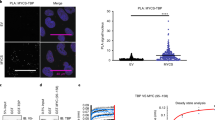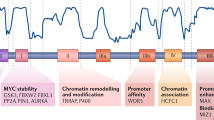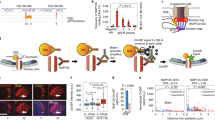Abstract
Myc proteins are transcriptional activators, but also repress transcription through initiator (Inr) elements. Repression requires the conserved Myc Box II, but the cis-acting element(s) required for c-myc autorepression have eluded definition. Since the gene has a candidate Inr at the P2 promoter, we tested whether Myc autorepression operates through the Inr/BoxII mechanism. Overexpression of c-Myc but not a Box II deletion mutation represses both c-myc P2 reporter genes and endogenous c-myc, as does Mxi1 expression. Only 45 nucleotides surrounding the P2 start suffice to mediate autorepression, but Myc and Mxi1 also downregulate P2 Inr mutations, suggesting other core promoter sequence requirements for autorepression. We tested the importance of conserved E2F sites, based on known Myc interaction with the pRb-related p107 and on the transrepressive effects of Rb family proteins. Myc, Mxi1, and p107 repress c-myc somewhat less well in the absence of E2F binding sites, while an E2F+Inr double mutation is not repressed at all by these gene products. Further, Myc repression at the c-myc P2 core promoter is augmented by p107, but not by pRb or p130, nor by p107 lacking the conserved pocket domain. Our data suggest that Myc autorepression requires both the c-myc Inr and E2F sites in cis, as well as p107 in trans. Consistent with this, we found that retrovirally transduced c-Myc cannot downregulate endogenous c-myc in p107-null fibroblasts, and show evidence that both Myc and p107 are present in a complex assembled at the c-myc P2 core promoter.
This is a preview of subscription content, access via your institution
Access options
Subscribe to this journal
Receive 50 print issues and online access
$259.00 per year
only $5.18 per issue
Buy this article
- Purchase on Springer Link
- Instant access to full article PDF
Prices may be subject to local taxes which are calculated during checkout






Similar content being viewed by others
References
Amati B, Dalton S, Brooks MW, Littlewood TD, Evans GI and Land H . (1992). Nature, 359, 423–426.
Ayer DA, Kretzner L and Eisenman RN . (1993). Cell, 72, 211–222.
Beijersbergen RL, Hijmans EM, Zhu L and Bernards R . (1994). EMBO J., 17, 4080–4086.
Bouchard C, Staller P and Eilers M . (1998). Trends Cell Biol., 8, 202–206.
Claassen GF and Hann SR . (1999). Oncogene, 18, 2925–2933.
Dagnino L, Zhu L, Skorecki KL and Moses HL . (1995). Cell Growth Differ., 6, 191–198.
Facchini LM, Chen S, Marhin WW, Lear JN and Penn LZ . (1997). Mol. Cell. Biol., 17, 100–114.
Gartel AL, Ye X, Goufman E, Shianov P, Hay N, Najmabadi F and Tyner AL . (2001). Proc. Natl. Acad. Sci. USA, 98, 4510–4515.
Grandori C, Mac J, Siëbelt F, Ayer DA and Eisenman RN . (1996). EMBO J., 15, 4344–4357.
Grignani F, Lombardi L, Inghirami G, Sternas L, Cechova K and Dalla-Favera R . (1990). EMBO J., 9, 3913–3922.
Gu W, Bhatia K, Magrath IT, Dang CV and Dalla-Favera R . (1994). Science, 264, 251–254.
Hamel PA, Gill RM, Phillips RA and Gallie BL . (1992). Mol. Cell. Biol., 12, 3431–3438.
Hann SR, King MW, Bentley DL, Anderson CW and Eisenman RN . (1988). Cell, 52, 185–195.
Hirst SK and Grandori C . (2000). Oncogene, 19, 5189–5197.
Hurford Jr RK, Cobrinik D, Lee M-H and Dyson N . (1997). Genes Dev., 11, 1447–1463.
Hurlin PJ, Queva C, Koskinen PJ, Steingrimsson E, Ayer DE, Copeland NG, Jenkins NA and Eisenman RN . (1995). EMBO J., 14, 5646–5659.
Javahery R, Khachi A, Lo K, Zenzie-Gregory B and Smale S . (1994). Mol. Cell. Biol., 14, 116–127.
Kretzner L, Blackwood EM and Eisenman RN . (1992). Nature, 359, 426–429.
Krumm A, Meulia T and Groudine M . (1993). BioEssays, 15, 659–665.
Krumm A, Hickey LB and Groudine M . (1995). Genes Dev., 9, 559–572.
Leder P, Battey J, Lenoir G, Moulding C, Murphy W, Potter H, Stewart T and Taub R . (1983). Science, 222, 765–771.
Lee TC and Ziff EB . (1999). J. Biol. Chem., 274, 595–606.
Li L-H, Nerlov C, Prendergast G, MacGregor D and Ziff EB . (1994). EMBO J., 13, 4070–4079.
Lipp M, Schilling R and Bernhardt G . (1989). Oncogene, 4, 535–541.
Lüscher B . (2001). Gene, 277, 1–14.
Mango SE, Schuler GD, Steele MER and Cole MD . (1989). Mol. Cell. Biol., 9, 3482–3490.
Marcu KB, Bossone SA and Patel AJ . (1992). Annu. Rev. Biochem., 61, 809–860.
Miller AD, Miller DG, Garcia JV and Lynch CM . (1993). Methods Enzymol., 217, 581–599.
Penn LZ, Brooks MW, Laufer EM and Land H . (1990a). EMBO J., 9, 1113–1121.
Penn LZ, Brooks MW, Laufer EM, Littlewood TD, Morgenstern JP, Evan GI, Lee WMF and Land H . (1990b). Mol. Cell. Biol., 10, 4961–4966.
Peters MA and Taparowsky EJ . (1998). Crit. Rev. Eukaryot. Gene Expression, 8, 277–296.
Roy AL . (2001). Gene, 274, 1–13.
Smale ST, Jain A, Kaufmann J, Emami KH, Lo K and Garraway IP . (1998). Cold Spring Harbor Symp. Quant. Biol., 63, 21–31.
Spencer CA and Groudine M . (1991). Adv. Cancer Res., 56, 1–48.
Spotts GD, Patel SV, Xiao Q and Hann SR . (1997). Mol. Cell. Biol., 17, 1459–1468.
Starostik P, Chow KNB and Dean DC . (1996). Mol. Cell. Biol., 16, 3606–3614.
Thalmeier K, Synovzik H, Mertz R, Winnacker E-L and Lipp M . (1989). Genes Dev., 3, 527–536.
Wade PA . (2001). Hum. Mol. Genet., 10, 693–698.
Wang JYJ . (1997). Curr. Opin. Genet. Dev., 7, 39–45.
Wanzel M, Herold S and Eilers M . (2003). Trends Cell Biol., 13, 146–150.
Weintraub SJ, Prater CA and Dean DC . (1992). Nature, 358, 259–261.
Wu C-L, Classon M, Dyson N and Harlow E . (1996). Mol. Cell. Biol., 16, 3698–3706.
Xiao Q, Claassen G, Shi J, Adachi S, Sedivy J and Hann SR . (1998). Genes Dev., 12, 3803–3808.
Yang W, Shen J, Wu M, Arsura M, FitzGerald M, Suldan Z, Kim DW, Hofmann CS, Pianetti S, Romieu-Mourez R, Freedman LP and Sonenshein GE . (2001). Oncogene, 20, 1688–1702.
Zhu L, van den Heuven S, Helin K, Fattaey A, Ewen M, Livingston D, Dyson N and Harlow E . (1993). Genes Dev., 7, 1111–1125.
Zhu L, Enders G, Lees JA, Beijersbergen RL, Bernards R and Harlow E . (1995). EMBO J., 14, 1904–1913.
Acknowledgements
In addition to reagent contributors, mentioned above, we thank Drs Bob Eisenman, Mark Groudine, Anton Krumm, Elizabeth Taparowsky, and Jean Wang for excellent discussions concerning this work. We also thank Dr Jack Williams, USD Medical School, for statistics consultations, and Dave Kruse and Giles Timms for technical assistance in early experiments. This work was supported by grants to LK from the National Science Foundation (EPSCoR Grant OSR-9452894) and the Life and Health Insurance Medical Research Fund.
Author information
Authors and Affiliations
Corresponding author
Rights and permissions
About this article
Cite this article
Luo, Q., Li, J., Cenkci, B. et al. Autorepression of c-myc requires both initiator and E2F-binding site elements and cooperation with the p107 gene product. Oncogene 23, 1088–1097 (2004). https://doi.org/10.1038/sj.onc.1207225
Received:
Revised:
Accepted:
Published:
Issue Date:
DOI: https://doi.org/10.1038/sj.onc.1207225
Keywords
This article is cited by
-
pVHL-Mediated Transcriptional Repression of c-Myc by Recruitment of Histone Deacetylases
Molecules and Cells (2012)
-
G1/S transcriptional networks modulated by the HOX11/TLX1 oncogene of T-cell acute lymphoblastic leukemia
Oncogene (2005)
-
Analysis of genomic targets reveals complex functions of MYC
Nature Reviews Cancer (2004)



